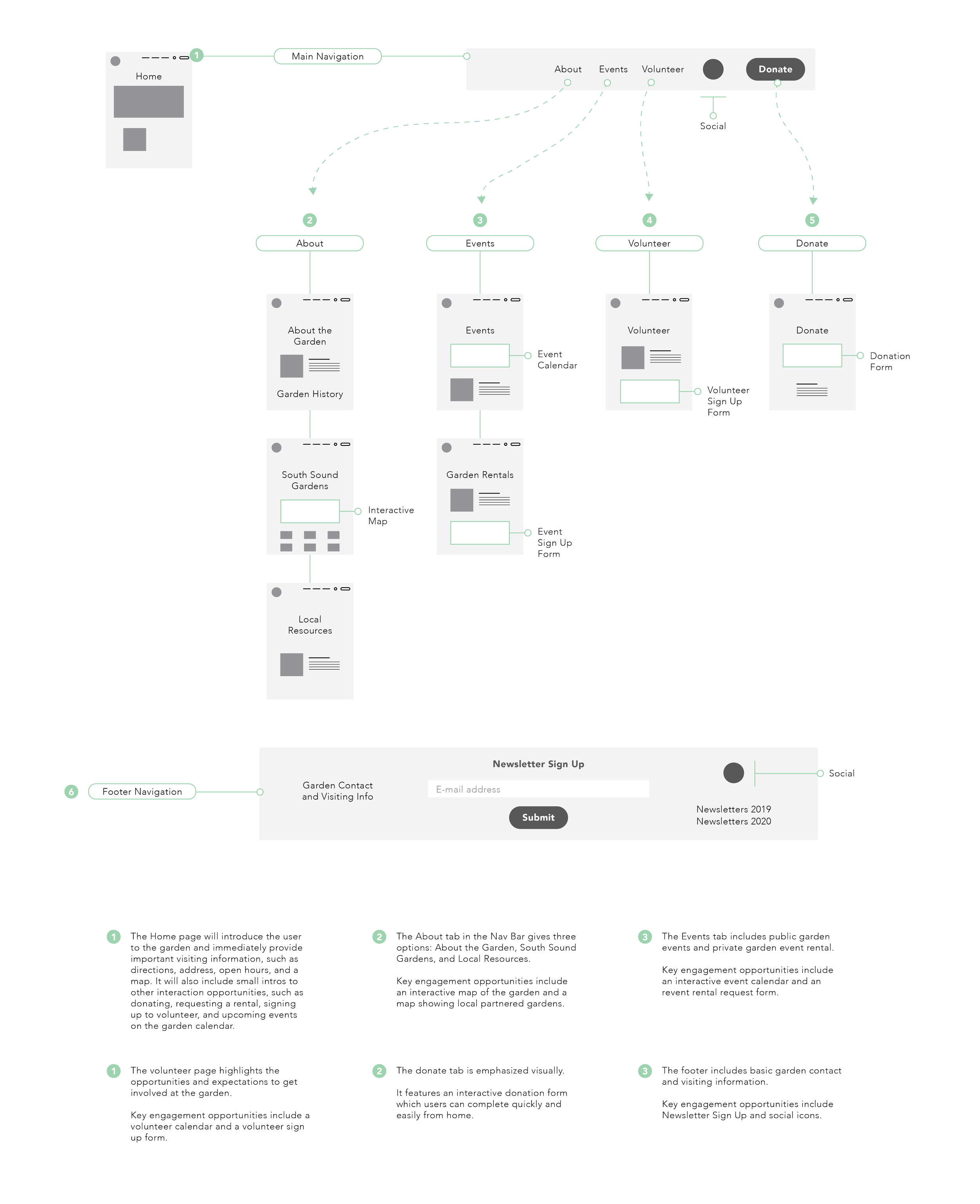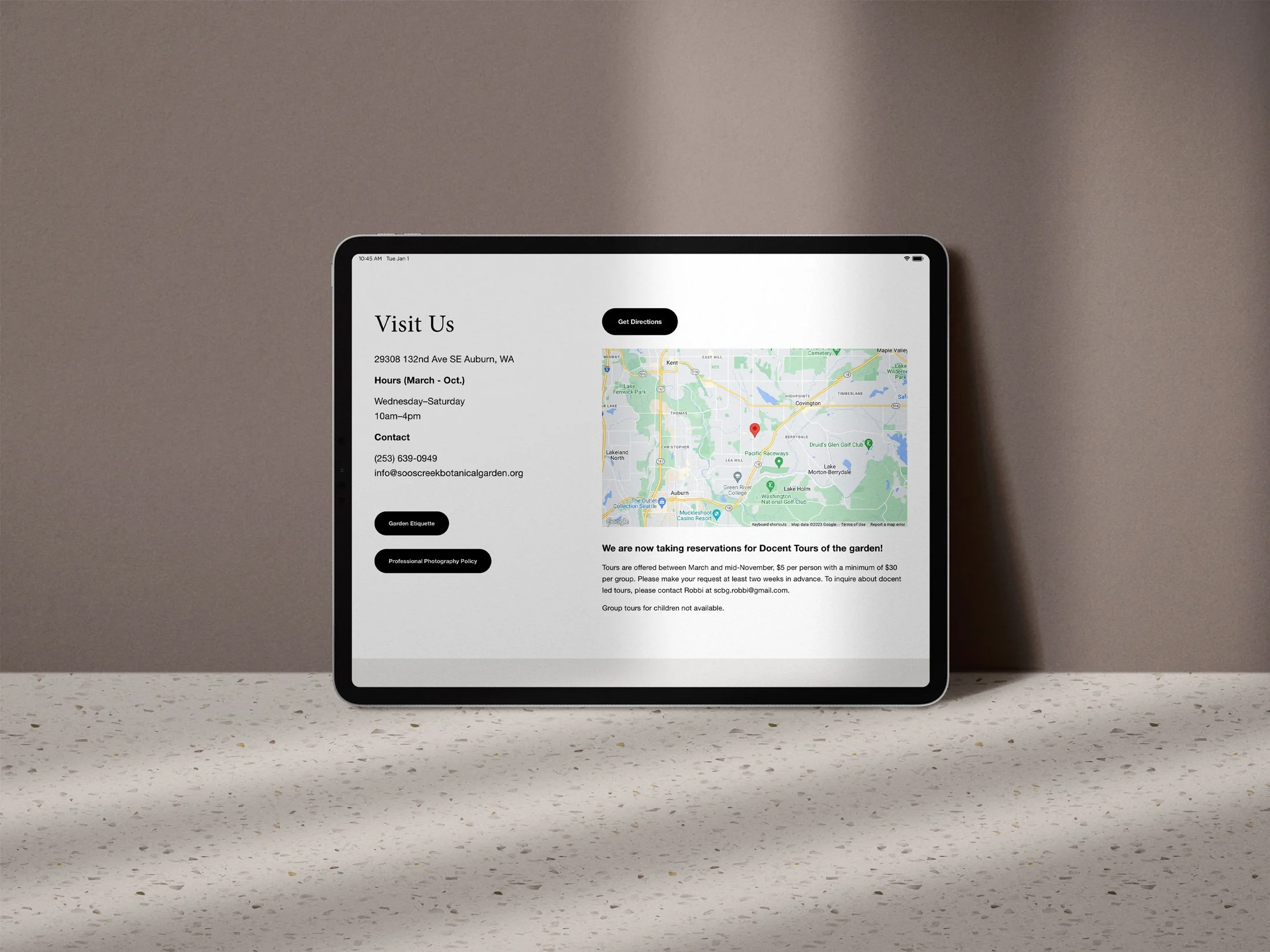Soos Creek Botanical Garden
Automating supportive systems for a low-tech non-profit
Role
UX/UI Design Consultant
Timeline
01/21 - 05/21
Background
I was hired to assess the existing website and redesign for improved CMS, engagement, traffic, and systems support.
Deliverables
User research
Reusable components library
Content Strategy
Website design
Easy-to use CMS
See it live:
Discovering user needs
Initial discovery
Poor navigation and unclear processes online resulted in a lack of engagement and disorganization in existing volunteer programs. Staff and volunteers were frustrated and struggled to coordinate support. I saw an opportunity to increase awareness of garden opportunities while automating common processes for volunteering, donations, event rentals, and other programs.
The garden had a very loyal group of older volunteers with low tech-literacy, which was a key aspect to creating appropriate design solutions.
Metrics to evaluate success
KPIs included engagement through volunteer sign ups, donations, and rental inquiries.
Validated personas
-

Val Veteran
Ages 60-80, retired, long time local, mostly female.
Behaviors / Activities
Gardens as a hobby. 5-10 year time investment in community. Cares deeply for the garden. Familiar with e-mail and google calendar.
Pain Points
Frustrated with the lack of organization in the garden. Too many tasks/expectations. Resistant to change.
Needs + Wants
Central source of information. Elimination of repetitive admin tasks. Simple, minimal maintenance of solutions. An easy way to integrate new people into existing processes.
-

Liz Local
Ages 20 - 40, any gender.
Behaviors / Activities
Wants to get involved in the local community. Likes to learn new skills and hobbies. Has visited the garden and enjoys it.
Pain Points
Doesn’t know about garden programs. Existing website is confusing. Does not consider contacting the garden manually. Disconnected from the existing community.
Needs + Wants
An easy way to get involved. Clear expectations for involvement. Connection with the existing SCBG community and their various ongoing events.
Solutions
-

Simplified IA and user flows.
The new IA focused on key engagement moments and easy navigation. allowing users to easily connect with their garden goals and interests.
Navigation links are simplified into key categories or CTAs.
Engagement opportunpties were murh more visible with standardized processes.
-

Volunteer Engagement
I provided online opportunities to both inquire about volunteering and see ongoing events. These need a low level of ongoing management and do not take the place of the preferred pen and pencil sign-up form used on-site.
Once we tested these new integrations, new volunteer attendance increased by 20%, and veteran volunteers were excited about the new system.
-

Key User Goals
Information for the most common user goals is featured first— including garden location, hours, and contact info — with many opportunities throughout the user journey to navigate back to this information.
-

Event Rental Requests
The opportunity for event rentals was made more visible on the new site with more information provided for interested users. An online sign up form also reduces the barrier for users to inquire.
Users can view rentable areas or request an event date or more information through an online form which is e-mailed to the SCBG staff.
Testing & Iterations
I conducted iterative testing to confirm the sustainability of solutions.
During usability testing, I asked 5 different people to attempt several tasks with no instructions. Tasks that seemed unclear were addressed and retested.
Event sign up was initially the least successful category. I discovered that the client was already familiar with Gmail products and found an opportunity to integrate signups through Google Calendar and Workspace.
The new use of Google calendars was a simple adjustment, but it resonated with both new and veteran users. Once implemented, new volunteer sign ups increased and veterans were excited about the ability to add events to their personal Google calendars.
Impact
Site traffic increased by 30% in the first 4 months after the new site was launched.
Volunteer engagement increased by 20% and veteran volunteers were excited about the ability to add events to their personal Google calendars.
With the new engagement, the garden was able to propagate over 1000 plants for their semi-annual plant sale.
A profit of $7,000 was made at their semi-annual plant sale — compared to an average of $2,000 in previous years.
The client can now maintain accessible and sustainable CMS chosen for their comfort levels and needs.
SEE IT LIVE:
Retrospective
Bridging the gap between the old ways of operation and the needs of new users was quickly successful after implementation. Visibility of garden opportunities dramatically improved, allowing online donations and volunteer inquiries for the first time.
Volunteer participation increased by 20% in the first two months and the garden was able to rehabilitate about 3 acres of land, propagate over 1000 plants, and make over $7,000 in profit at their semi-annual plant sale — compared to an average of $2,000 in previous years.
On top of that, the client is now able to manage ongoing website updates to event calendars and more due to a CMS system chosen for their comfort level and needs.
Last


